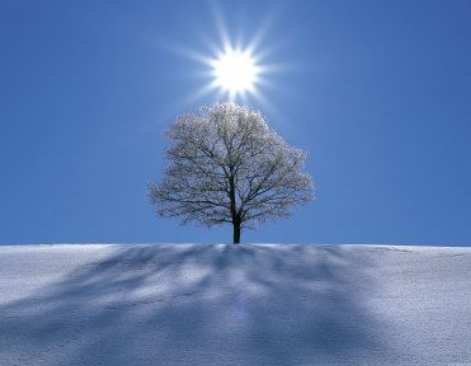A quick peek at the blog shows how much we like to celebrate the change of seasons as we honor them each time they come around – Summer, Fall, Spring, and Winter. And now Winter again. For this post Fraser Hibbitt takes over the reins to welcome Winter Solstice, once again.
Carl Kruse
The cycle of the seasons has always informed our experience of living. For many today, our way of living does not require us to change how we approach our lives; we no longer feel that the supply of food will fail to be stocked, or our home in lack of heat. Yet it is still undeniable what the seasons mean to us; what we feel when the sun begins to lower in the sky after the high months of summer. It is in the third week of December that the sun falls to its lowest elevation in the sky and we are met with the longest night.
The winter solstice is the darkest day, but it is also the day when the sun begins to climb back towards its zenith. We understand this, but we do not feel it. During these weeks of December, the sun appears to be at a point of hesitation; the term ‘solstice’ derives from the Latin phrase for the ‘sun standing still’. Daylight does not wax nor does it wan, rather it signals an end of the sun’s descent.

It has been through the wonderful communication of ritual that humans have been able to communally express this signal together. We can see it played out in ancient civilizations in the form of resurrection and birth. The Egyptian deity Osiris and the ancient Greek god Dionysus both figured as symbols for celebration during this time; Osiris, the deity of fertility is said to be resurrected; Dionysus, the god of wine and life energy, is born. Communities were celebrating the return of life which would give them hope through the winter months; it was a time for sowing and slaughter, and for the enjoyment of long brewed alcohol.
When we look at the ancient pagan rituals around the time of the winter solstice, we can begin to appreciate the origin of many forms we still see intact today. The ancient Roman festival of Saturnalia begun on the 17th of December and ended on the 23rd. This was a celebration of the god Saturn who is thought to have represented the Golden Age of peace. Saturnalia involved role reversals in which slaves could be masters; huge feasts; public sacrifices; gift-giving; colorful clothing, a hat called the pilleus, and even a festive greeting: ‘Io Saturnalia’.
We find similar rituals taking place in Northern Europe and the British Isles. Druids, or Celtic priests, believed that the sun stood still for twelve days and it was in this time to burn an oak log to ward of the dark, evil spirits and hope for an abundant year. Druidry was especially concerned with nature; it is from them that we have received the traditional cutting of the mistletoe to give as a blessing during this time.
If we look east, we come across the tradition of Yalda Night, a Persian tradition. Yalda night shares similarities with the European traditions with its focus on food and light. On the 21st of December, families get together to eat and recite poetry. It is believed that this time of the year is inauspicious and pregnant with evil spirits. Yalda night serves as a defence against such spirits by gathering in communal groups, eating and staying up until the late hours, facing the night together.
The ritual, in its various forms, becomes a way to connect with nature, time, and each other. The activities of the winter solstice are coloured by the idea of life; of preserving life and of celebrating life. We can see this in the tradition of populating the domestic space with the yule tree, evergreen bushes and holly; preserving the life blood of nature with our warmth. These symbols of life command our duty to conserve life until the spring.
This dynamic with nature, then, is ours to create. The early onset of evening is fought against by candles and fire; the tree is brought inside and decorated, praised and admired. The solstice celebration is an adaptive act against the anxiety of the barren months to come. We are setting reminders to ourselves, and all those that pass, that there still is light and a life to come.
Many of these traditions evolved and became widespread via the Christian faith. Jesus Christ, the bringer of light, would take over from the older gods to have his name day coincide within the winter solstice period. The Christmas period has taken on much of the practices which we see in the earlier Pagan rituals and it is difficult to evoke the winter solstice without speaking about the practices of Christmas.
The month of December is now fraught with the pageantry of Christmas that we may forget about the sun becoming ‘reborn’. However, there are still those dedicated to the remembrance of this event. Every year, crowds gather to a site in Salisbury, England, to witness the sunrise at Stonehenge. This prehistoric monument embodies a dedication towards the returning sun; unfortunately, this year (2020) it will have to be livestreamed, but the fact that it will be tells us something of its importance.
But there are numerous ways to appreciate this time of the year. The fact that Christmas has taken the role of many of the winter solstice practices only means that they function under a different guise; we still feel that something is astir as we sit around the table for Christmas dinner; or, as when we walk home and find our way lit by decorative lights.
The festive spirit is a piece of advice inherited through the dual feelings of anxiety and hope. The modern appeal to cover these feelings up with the stress of commercialism seems a poor substitute; the desire to achieve happy, worthy gift-giving. Only a few gifts will stand the test of time, and probably only for memory’s sake. The winter solstice offers us a time when we can be in touch with those around us and be sensitive to nature’s changing status; where the worries of anxiety can be removed by the celebrations of hope. Happy Winter Solstice.
==============
Contact: carl AT carlkruse DOT com
For the exact timing of the 2020 Winter Solstice see the EarthSky site here.
A New York Times a piece on the solstice.

Yo yo yo Kruse. A few days late but Happy Winter Solstice man. And today – MERRY CHRISTMAS!
Love how you relish the seasons and how you focus on them here.